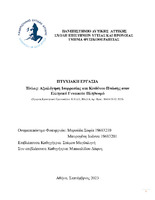| dc.contributor.advisor | Στάμου, Μαγδαληνή | |
| dc.contributor.advisor | Μπακαλίδου, Δάφνη | |
| dc.contributor.author | Μαρούδα, Σοφία | |
| dc.contributor.author | Μαυρογένη, Ιωάννα | |
| dc.date.accessioned | 2023-09-27T07:09:55Z | |
| dc.date.available | 2023-09-27T07:09:55Z | |
| dc.date.issued | 2023-09-22 | |
| dc.identifier.uri | https://polynoe.lib.uniwa.gr/xmlui/handle/11400/5143 | |
| dc.identifier.uri | http://dx.doi.org/10.26265/polynoe-4981 | |
| dc.description | Πιλοτική Περιγραφική Μελέτη | el |
| dc.description.abstract | Εισαγωγή: Έρευνες αναφέρουν, ότι τα ελλείμματα στην ισορροπία, αυξάνουν τον κίνδυνο και τα περιστατικά πτώσεων, οδηγώντας τελικά στην ανάπτυξη φόβου πτώσης.
Σκοπός: Σκοπός της παρούσης πιλοτικής περιγραφικής μελέτης ήταν η διερεύνηση της συσχέτισης της ισορροπίας με τον κίνδυνο πτώσης στον ελληνικό γυναικείο πληθυσμό.
Μέθοδος: Για την εκπόνηση της παρούσης εργασίας, στρατολογήθηκαν, συνολικά, 44 γυναίκες, άνω των 50 ετών, χωρίς ιστορικό νευρολογικής πάθησης. Πραγματοποιήθηκε λήψη ιστορικού (ηλικία, φύλο), καταγραφή δείκτη μάζας σώματος (ΔΜΣ) και ιστορικού χρόνιας πάθησης. Για την αξιολόγηση της δυναμικής ισορροπίας καταγράφηκαν οι αποδόσεις στις δοκιμασίες Functional Reach Test (FRT) και Timed Up and Go (TUG) και για την στατική ισορροπία η απόδοση στη δοκιμασία 30 seconds Sit-To-Stand (30STS). Ακόμη, χρησιμοποιήθηκε η ελληνική έκδοση της αυτοσυμπληρούμενης κλίμακας Falls Efficasy Scale-International (FES-I) για την καταγραφή της ανησυχίας για πτώση των συμμετεχουσών. Οι συσχετίσεις μεταξύ των μεταβλητών υπολογίστηκαν με τον συντελεστή συσχέτισης του Pearson (r) και τιμή του p ορίστηκε ως μικρότερη του 0.05 [< 0.05] στατιστικά σημαντική διαφορά. Το τεστ Kolmogorov-Smirnov εξέτασε την κανονική κατανομή των παραμέτρων.
Αποτελέσματα: Τα αποτελέσματα της συσχέτισης των μεταβλητών κατά ζεύγη έδειξαν μέτρια και αρνητική συσχέτιση με στατιστικά σημαντική διαφορά μεταξύ του ιστορικού χρόνιας πάθησης και της αυτοσυμπληρούμενης κλίμακας FES-I (r= -.399, p= .007).
Συμπεράσματα: Ανευρέθηκε στατιστικά σημαντική διαφορά μεταξύ του ιστορικού χρόνιας πάθησης και του φόβου πτώσης. Έγινε φανερή η επίδραση της ηλικίας, του δείκτη μάζας σώματος και του ιστορικού χρόνιας πάθησης στην απόδοση των κλινικών δοκιμασιών (FRT, 30STS, TUG) και το αυτοσυμπληρούμενο ερωτηματολόγιο (FES-I), παρόλο που δεν ανευρέθηκαν άλλες στατιστικά σημαντικές διαφορές. Επομένως, προτείνεται να διεξαχθούν περαιτέρω ερευνητικές μελέτες με μεγαλύτερο αριθμό δείγματος, με σκοπό τη διερεύνηση της σχέσης της ισορροπίας με τον κίνδυνο πτώσης. | el |
| dc.format.extent | 49 | el |
| dc.language.iso | el | el |
| dc.publisher | Πανεπιστήμιο Δυτικής Αττικής | el |
| dc.rights | Αναφορά Δημιουργού - Μη Εμπορική Χρήση - Παρόμοια Διανομή 4.0 Διεθνές | * |
| dc.rights | Attribution-NonCommercial-NoDerivatives 4.0 Διεθνές | * |
| dc.rights.uri | http://creativecommons.org/licenses/by-nc-nd/4.0/ | * |
| dc.subject | Ισορροπία | el |
| dc.subject | Φόβος Πτώσης | el |
| dc.subject | Γυναίκες | el |
| dc.subject | Functional Reach Test | el |
| dc.subject | 30 seconds Sit-To-Stand | el |
| dc.subject | Timed Up and Go | el |
| dc.subject | Falls Efficasy Scale-International | el |
| dc.title | Αξιολόγηση Ισορροπίας και Κινδύνου Πτώσης στον Ελληνικό Γυναικείο Πληθυσμό | el |
| dc.title.alternative | Assessment of Balance and Risk of Fall in the Greek Female Population | el |
| dc.type | Πτυχιακή εργασία | el |
| dc.contributor.committee | Παπαδοπούλου, Μαριάννα | |
| dc.contributor.faculty | Σχολή Επιστημών Υγείας & Πρόνοιας | el |
| dc.contributor.department | Τμήμα Φυσικοθεραπείας | el |
| dc.description.abstracttranslated | Introduction: Research indicates that deficits in balance increase the risk and incidence of falls, ultimately leading to the development of a fear of falling.
Purpose: The aim of this pilot descriptive study was to investigate the correlation between balance and risk of fall in Greek female population.
Methods: Method: To prepare this work, a total of 44 women, over 50 years old, without a history of neurological disease, were recruited. History (age, gender), body mass index (BMI) and chronic disease history were recorded. Functional Reach Test (FRT) and Timed Up and Go (TUG) tests were used to evaluate dynamic balance, and performance in the 30 seconds Sit-To-Stand (30STS) test for static balance. Furthermore, the Greek version of the Falls Efficacy Scale-International (FES-I) self-completed scale was used to record participants' concern about falling. Correlations between variables were calculated with Pearson's correlation coefficient (r) and a p value of less than 0.05 [< 0.05] was defined as a statistically significant difference. The Kolmogorov-Smirnov test examined the normal distribution of the parameters.
Results: The results of the pairwise correlation of the variables showed a moderate and negative correlation with a statistically significant difference between the chronic disease history and the FES-I self-report scale (r= -.399, p= .007).
Conclusions: A statistically significant difference was found between chronic disease history and fear of falling. An effect of age, body mass index and chronic disease history on clinical test (FRT, 30STS, TUG) and self-administered questionnaire (FES-I) performance was evident, although no other statistically significant differences were found. Therefore, it is suggested that further research studies with a larger sample size needs to be conducted to investigate the correlation between balance and fall risk. | el |


